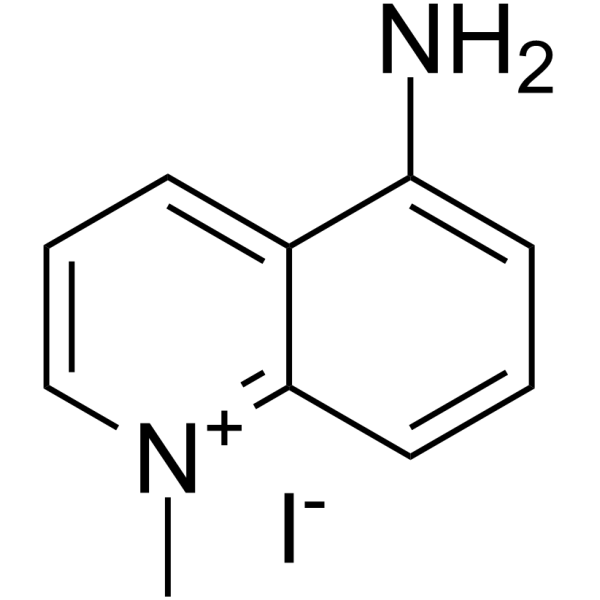| Cas No.: | 42464-96-0 |
| Chemical Name: | 5-Amino-1-methylquinolinium iodide |
| Synonyms: | NNMTi |
| SMILES: | C[N+]1=C2C=CC=C(N)C2=CC=C1.[I-] |
| Formula: | C10H11In2 |
| M.Wt: | 286.11 |
| Purity: | >98% |
| Sotrage: | 2 years -20°C Powder, 2 weeks 4°C in DMSO, 6 months -80°C in DMSO |
| Description: | NNMTi is a potent nicotinamide N-methyltransferase (NNMT) inhibitor (IC50=1.2 μM) and selectively binds to the NNMT substrate-binding site residues[1]. NNMTi promotes myoblast differentiation in vitro and enhances fusion and regenerative capacity of muscle stem cells (muSCs) in aged mice[2]. |
| In Vivo: | NNMTi (subcutaneous (SC) injection; 5 mg/kg and 10 mg/kg; 2 weeks (1 week pre-injury and 1 week post-injury)) has an effect on muscle regeneration after injury, it results in 60% and 75% higher incidence of proliferating/active muSCs at 5 mg/kg and 10 mg/kg, respectively. The relative numbers of fibers with an EdU+ myonucleus increased 40% and 48% with NNMTi treatment at 5 mg/kg and 10 mg/kg, respectively. The odds ratio of fused myonuclei for control are 0.58 and 0.53 times the odds at the low and high NNMTi dose, respectively[1]. NNMTi (subcutaneous injection; 10 mg/kg; 1 week) produces no systemic toxicity in mice, the levels of the glucose, cholesterol, plasma proteins, and electrolytes between control and NNMTi-treated samples show no difference in mice. 1-week post-injury daily repeat-dosing of NNMTi is well tolerated with no untoward systemic toxicity or behavioral implications in aged mice[1]. |
| In Vitro: | NNMTi (10-30 µM; 96 hours) produces a concentration-related increase in myoblast differentiation on C2C12 myoblast differentiation. 30 µM NNMTi results in 18% MHC-positive myotube nuclei, representing a 45% increase in the extent of myoblast differentiation compared to untreated differentiating myoblasts (12% MHC-positive myotube nuclei)[2]. |
| References: | [1]. Harshini Neelakantan, et al. Small molecule nicotinamide N-methyltransferase inhibitor activates senescent muscle stem cells and improves regenerative capacity of aged skeletal muscle. Biochem Pharmacol. 2019 May;163:481-492. [2]. Harshini Neelakantan, et al. Structure-Activity Relationship for Small Molecule Inhibitors of Nicotinamide N-Methyltransferase. J Med Chem |

 To enhance service speed and avoid tariff delays, we've opened a US warehouse. All US orders ship directly from our US facility.
To enhance service speed and avoid tariff delays, we've opened a US warehouse. All US orders ship directly from our US facility.




















